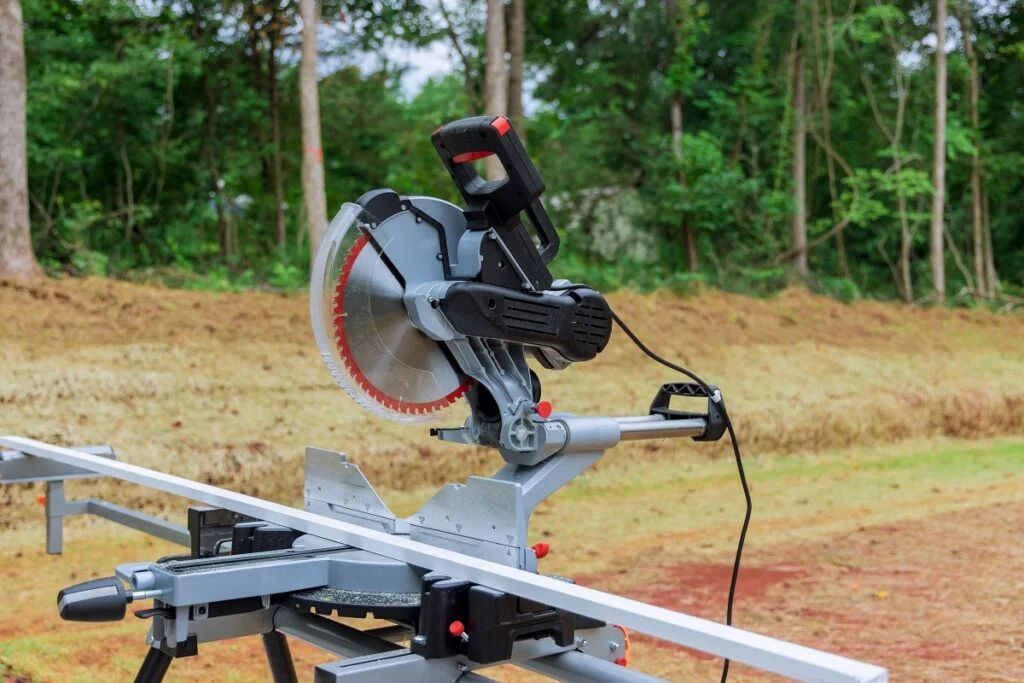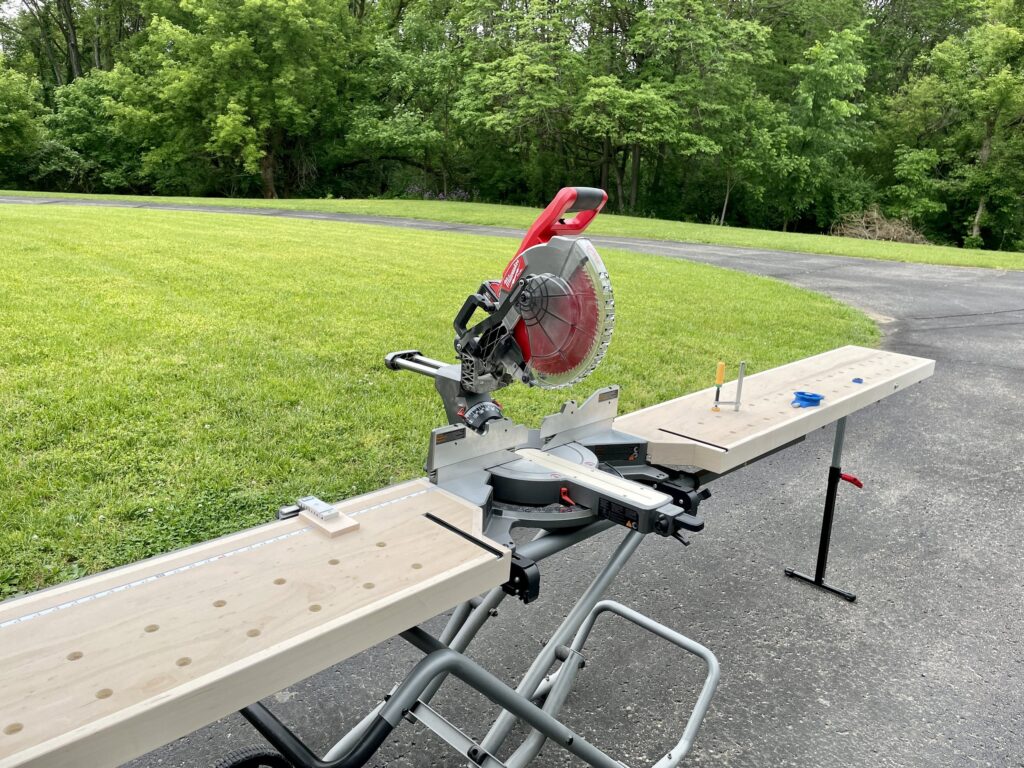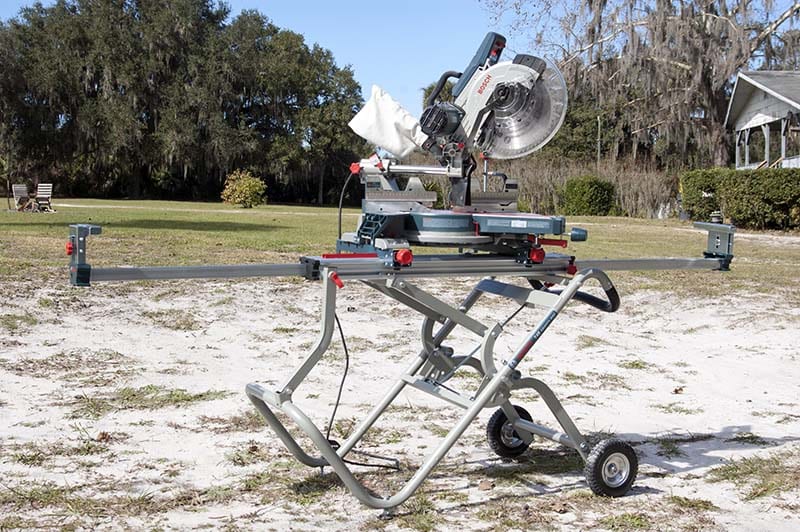Are miter saw stands universal? This question often crosses the minds of woodworking enthusiasts and professionals alike when searching for the perfect accessory to complement their miter saws. In the world of woodworking, efficiency and precision are critical, and a miter saw stand can significantly enhance these aspects of your work.
But before you invest in one, it’s essential to understand whether these stands can universally fit various miter saw models or if compatibility issues may arise. In this exploration, we’ll delve into the concept of universal miter saw stands, exploring the factors determining their compatibility with different saws and helping you make an informed decision for your woodworking needs.
Understanding Miter Saw Stands
Miter saw stands are essential accessories for woodworkers and carpenters who use miter saws for cutting wood, metal, or other materials with precision. These stands provide a stable and elevated platform for the miter saw, enhancing safety, accuracy, and convenience during cutting tasks. Here’s a comprehensive understanding of miter saw stands:
Critical Components of a Miter Saw Stand
Frame: The frame of a miter saw stand forms the base and structure of the stand. It is typically made of metal (such as steel or aluminum) for durability and stability. Some frames have foldable or collapsible designs for portability and easy storage.
Mounting Brackets or Clamps: These components secure the miter saw to the stand’s top surface. Universal stands often feature adjustable mounting brackets or clamps to accommodate various miter saw sizes and models.
Work Supports and Extensions: Miter saw stands may include work supports or extensions that provide additional material support on either side of the saw. These extensions can be extended or retracted as needed to handle longer workpieces.
Adjustable Height: Many miter saw stands offer height-adjustable legs or feet. This feature allows users to set the stand at a comfortable working height and adapt to uneven surfaces.
Wheels and Mobility: Some stands have built-in wheels, making them easily transportable around job sites or workshops. This mobility feature is handy for professionals working on different projects.
Folding Mechanism: Many miter saw stands have a folding or collapsing mechanism that allows the stand to be compactly stored or transported. This is advantageous for those with limited workshop space.
Dust Collection Ports: Some stands come with integrated dust collection systems or ports that help manage sawdust and maintain a cleaner workspace. This is beneficial for indoor or enclosed area use.
Types of Miter Saw Stands
Universal Stands: These stands accommodate many miter saw brands and models. They are adjustable and versatile, making them suitable for users with multiple miter saws or those planning to upgrade their saw.
Non-Universal Stands: Non-universal stands are specifically tailored to fit certain miter saw models or a closely related range of models from the same manufacturer. They offer precise fit and stability.
Rolling Stands: Rolling miter saw stands have built-in wheels for easy transportation. They are famous for professionals who must move their miter saw setup between job sites.
Stationary Stands: Stationary stands are fixed in place and do not have wheels. They are suitable for workshops where the stand remains in one location.
Benefits of Using a Miter Saw Stand
Enhanced Stability: Miter saw stands provide a stable and level platform for the saw, reducing the risk of inaccuracies and ensuring safer operation.
Improved Accuracy: By elevating the saw to a comfortable working height and providing extensions for more extended materials, miter saw stands help users quickly make precise cuts.
Safety: Using a miter saw on a stable stand reduces the chances of accidents or kickbacks, promoting a safer working environment.

Convenience: Miter saw stands with mobility features, such as wheels, make it easier to move the setup as needed, saving time and effort.
Space Efficiency: Folding or collapsible miter saw stands are space-efficient and ideal for those with limited workshop or storage space.
Critical features of the miter saw stands
Miter saw stands have several vital features that greatly influence their utility and effectiveness. One of the most significant attributes is adjustability, which includes height adjustment, allowing users to set the stand at a comfortable working level and adapt to uneven surfaces. Many stands also feature extensions that can be extended or retracted to provide additional support for longer workpieces.
Stability
Stability is another crucial factor, with sturdy frames developed from rigid materials like steel or aluminum ensuring a stable and vibration-free platform for cutting tasks. Adjustable leveling feet on the stand’s legs help achieve a level surface, even on uneven terrain.
Portability
Portability is a notable feature in miter saw stands, often provided by built-in wheels and foldable designs, making transportation effortless, especially for professionals on the move.
Mounting brackets or clamps play a vital role in securing the miter saw to the stand’s surface, with universal compatibility for a wide range of saw brands and models or non-universal stands designed for precise fits. Integrated dust collection ports contribute to workspace cleanliness.
Factors Influencing the Universality of the Miter Saw
The universality of a miter saw, referring to its flexibility and capacity to deal with a wide variety of tasks and materials, is influenced by several key factors. These factors determine the saw’s adaptability to different projects and applications. Here are the primary factors that influence the universality of a miter saw:
Miter and Bevel Range: The miter saw’s ability to make various angled cuts is a critical factor. A saw with a broad miter range (e.g., from -45 to +45 degrees) provides more flexibility for making precise miter cuts. Additionally, the ability to tilt the blade for bevel cuts (typically from 0 to 45 degrees or more) enhances the saw’s versatility.
Blade Size: The size of the saw’s blade affects its capacity to cut through different materials and sizes. Miter saws are available with blade sizes ranging from 7 creeps to 12 inches or more. Larger blades can handle thicker materials and broader boards, increasing the saw’s universality.
Motor Power: The motor’s wattage or amperage rating influences the saw’s cutting capability. Higher-powered motors can handle denser and more complex materials, making them more versatile for various tasks.

Cutting Depth and Width: The saw’s ability to cut at various depths and widths is essential for accommodating different workpiece sizes and thicknesses. Adjustable depth stops and sliding features on some models enable more remarkable universality.
Cutting Angles and Stops: Look for miter saws with positive stops at joint angles like 45 degrees and 90 degrees, as these make it easier to set precise angles quickly. Some models also offer detents at other angles, enhancing their versatility.
Dual-Bevel Capability: A miter saw with dual-bevel capability can tilt the blade in both left and right directions, allowing for complex compound cuts without flipping the workpiece. This feature significantly increases the saw’s universality.
Laser Guides and LED Lighting: Built-in laser guides or LED lighting systems help improve cutting accuracy, making the saw more adaptable to various tasks, including detailed woodworking and fine carpentry.
Dust Collection: Efficient dust collection systems keep the workspace clean, improve visibility, and contribute to the saw’s adaptability, especially when working with sensitive materials or indoors.
Portability: The saw’s weight and design influence its portability. Models with ergonomic handles and lighter frames are easier to transport and use on different job sites, enhancing their universality.
Accessories and Attachments: The availability of accessories like stands, extension tables, and clamps can expand the miter saw’s capabilities, making it more adaptable for different projects.
Brand and Model Features: Different brands and models may offer unique features or innovations that enhance the universality of the miter saw. Researching and comparing various models can help you find one that suits your needs.
Universal vs. Non-Universal Miter Saw Stands
The choice between a universal and a non-universal miter saw stand depends on your specific needs, preferences, and the type of miter saw you have. Let’s explore the key differences between these two types of stands:
Universal Miter Saw Stand
Compatibility: Universal miter saw stands are intended to be viable with various miter saw brands and models. They typically feature adjustable mounting brackets or clamps that accommodate different saw sizes and designs.
Versatility: These stands are highly versatile and can be used with various miter saws, making them a suitable choice if you own multiple miter saws or plan to upgrade your saw. They are also adaptable to different job site requirements.
Ease of Setup: Universal stands are generally designed for quick and easy setup. The adjustable brackets or clamps make securing your miter saw to the stand convenient without requiring custom fittings or modifications.
Portability: Many universal stands are designed with portability in mind. They often feature folding legs, wheels, or handles for easy transportation between job sites.
Cost-Effective: Universal miter saw stands are often cost-effective because they can be used with various saws, reducing the need for purchasing multiple stands for different saw models.
Non-Universal Miter Saw Stand
Specific Fit: Non-universal stands are designed to fit a specific miter saw model or a range of closely related models from the same manufacturer. They are engineered to provide a precise fit, ensuring stability and security.
Stability: Because non-universal stands are tailored to fit specific saws, they offer excellent stability and support during use. This can be especially important when working with heavy or oversized miter saws.
Custom Features: Some non-universal stands may include custom features, such as integrated extensions, material supports, or built-in clamping systems specifically designed to enhance the performance of a particular saw model.
Durability: These stands are often built to withstand the rigors of professional use and may have a more robust construction than universal stands.
Precise Adjustments: Non-universal stands can provide precise adjustments and settings that align perfectly with the saw’s design, allowing for accurate and repeatable cuts.
Choosing between a universal and a non-universal miter saw stand depends on your priorities and requirements. A universal stand may be the better choice if you have multiple miter saws, prefer versatility, and want an economical solution. On the other hand, if you value a precise fit, stability, and custom features tailored to your specific saw model, a non-universal stand designed for your saw may be the way to go. Carefully consider your needs and the features of both types of stands before deciding.
Tips for Choosing the Right Miter Saw Stand
Choosing the right miter saw stand is essential for ensuring stability, accuracy, and efficiency when using your miter saw. Here are some tips to help you select the ideal miter saw stand for your needs:
Consider Compatibility
Guarantee that the stand you pick is viable with your miter saw model. Some stands are designed for specific saws, while others are universal and can accommodate various brands and models. Verify that your saw will fit securely on the stand.
Weight Capacity
Check the weight capacity of the stand. It should comfortably support the weight of your miter saw, including any potential extensions or accessories you plan to use. Opt for a stand with a higher weight capacity for added stability.
Portability
Determine if portability is a priority for your work. Look for stands with features like foldable legs, built-in wheels, or carrying handles. These make transporting the stand to different job sites easier or storing it when not in use.
Stability and Support
Stability is crucial for accurate cuts. Evaluate the stand’s design and construction to ensure it provides a stable and level platform for your miter saw. Look for stands with adjustable leveling feet to accommodate uneven surfaces.
Material Supports and Extensions
Consider whether you need material supports or extensions. Some stands come with integrated extensions or material supports to handle longer workpieces. These can be valuable for cutting more extensive materials or working with longer boards.
Height Adjustability
Check if the stand offers height adjustability. Adjustable stand heights can help you find a comfortable position and adapt to different tasks and workspaces.
Quick Setup and Assembly
Look for stands that offer quick and easy setups. A stand with straightforward assembly and tool-free adjustments can save you time and frustration.
Dust Collection Compatibility
If dust collection is essential in your workspace, consider whether the stand is compatible with your miter saw’s dust collection system. Some stands have built-in features to help manage sawdust and maintain a clean work area.
Durability and Build Quality
Assess the durability and build quality of the stand. Stands made from sturdy materials like steel or aluminum tend to be more robust and long-lasting. Durability is essential for professional use.
Budget and Value
Set a budget for your miter saw stand, but also consider the value it provides. Spending a bit more for added features, stability, and durability can be a wise investment in the long run.
Conclusion
Whether miter saw stands are universal has been thoroughly explored, and the answer is not a straightforward yes or no. While many miter saw stands are designed to accommodate a wide range of miter saw brands and models, there are still variations in size, weight capacity, and compatibility that can make it necessary to match your saw with the suitable stand carefully.
It is essential to consult the manufacturer’s specifications and guidelines to ensure a proper fit. As technology advances and new saw models are introduced, the concept of universality may continue to evolve. It is advisable for users to stay informed about the latest product offerings and advancements in miter saw stand design to make informed decisions about compatibility.

